Java 7 Update 13 is now available. This is a critical update to address zero-day security vulnerability.
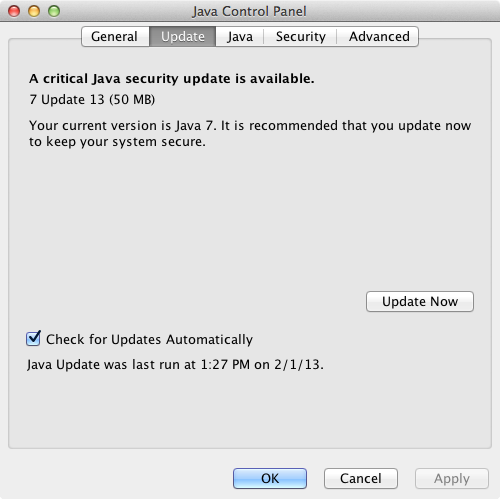
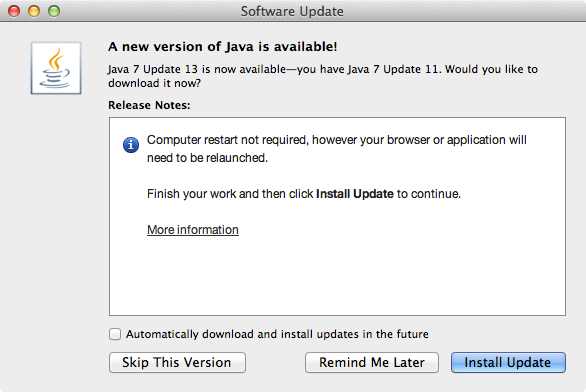
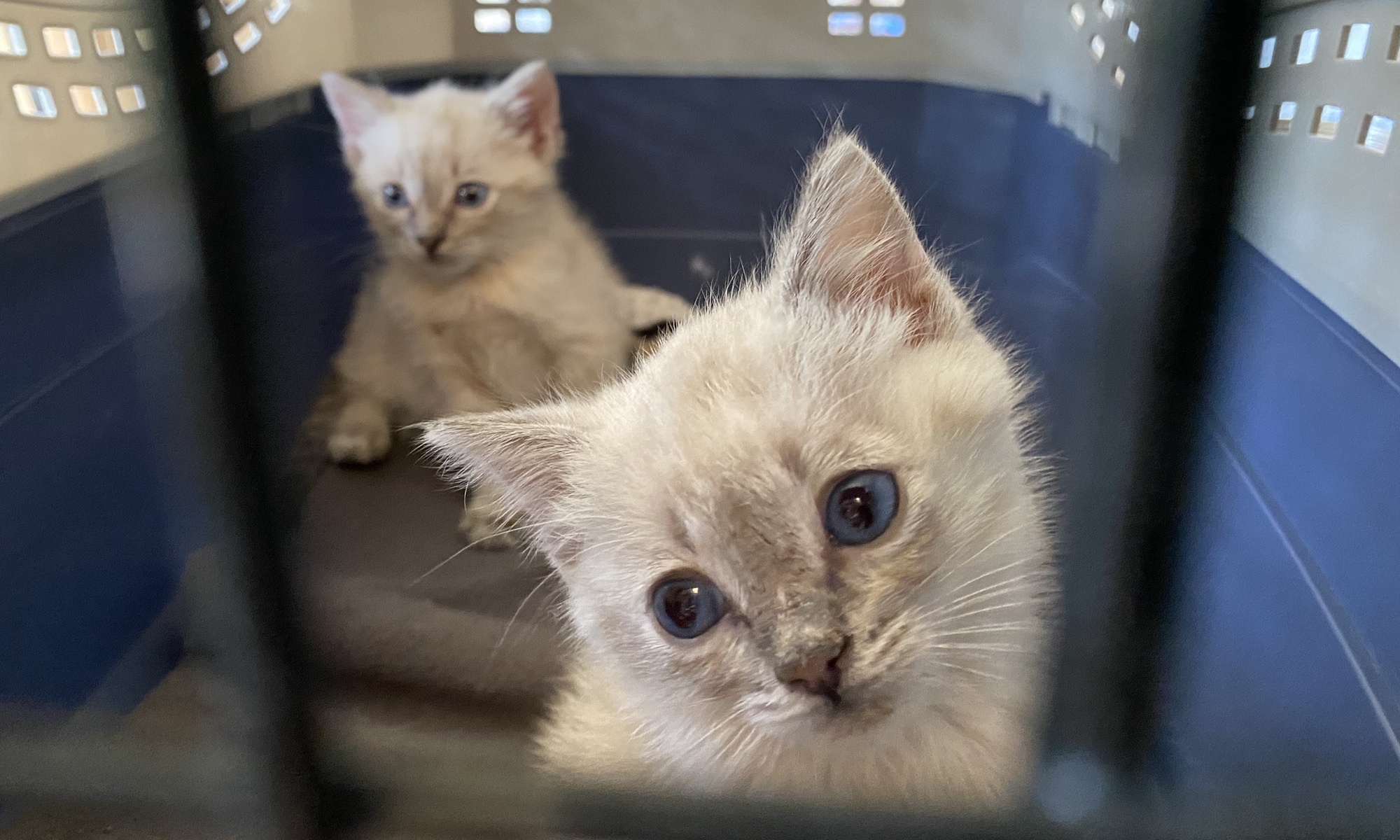
Now pointlessly enhanced with AI
Java 7 Update 13 is now available. This is a critical update to address zero-day security vulnerability.


Oracle releases Java 7 Update 11 to address vulnerability. If you do not need Java at all, it is advisable to uninstall it completely.
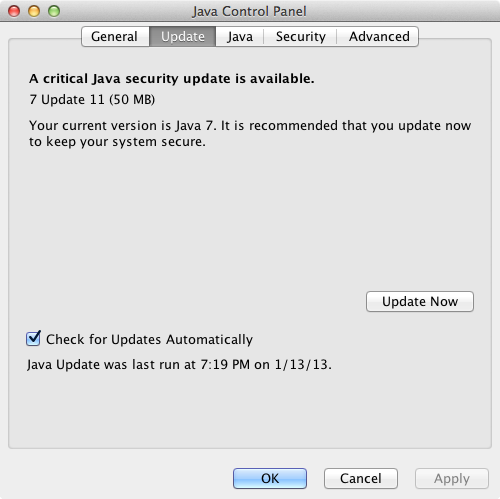

If the auto update failed, download Java 7 Update 11 manually.
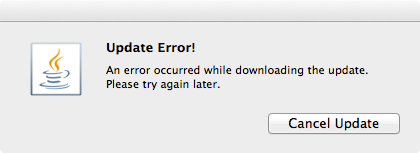
Current news about Java vulnerabilities have been the talk of both tech and mainstream press. The U.S. Department of Homeland Security issued a warning of this vulnerability on Thursday January 10, 2013. On Friday January 11, 2013 we received numbers of called from users that their computers were infected by malware on that day. Security softwares such as Malwarebytes Anti-Malware and Microsoft Security Essentials detected the presence of malicious Java codes in the computers.
Companies like Apple and Mozilla Foundation have been pro-actively blocked Java on their platform.
This is certainly not the first time Java has been exploited to deliver malware. Back in August 2012 similar outbreak of malware used Java vulnerability as point of entry. Oracle says that they are preparing an update to Java to address the vulnerability.
So, I have successfully removed the ransomware/malware form the infected computer.
Booting the computer up to Safe Mode or Safe Mode with Networking would still activate the malware. That’s because it replaces the registry entry for Windows Shell from “Explorer.exe” to something else. So, boot the computer to “Safe Mode with Command Prompt” and type “regedit.exe” at the command prompt.
In registry editor, go to:
HKEY_LOCAL_MACHINESOFTWAREMicrosoftWindows NTCurrentVersionWinlogon
In this particular case it was replaced with:
C:PROGRA~3dsgsdgdsgdsgw.bat
Delete the entry and replace it with:
Explorer.exe
Reboot the computer into “Safe Mode with Networking” and launch a web browser. Download, install and run the following programs if you haven’t already:
There are also other programs to scan and remove the malware.
Combofix detects that userinit.exe s also infected.
Microsoft Security Essentials also detected presence of Trojan:JS/Reveton.A, which was detected on January 11, 2013.
This computer was infected on Friday January 11, 2013, shortly after news about Java vulnerability was reported. After further investigations, I found that the infection happened through Java vulnerability. The infected computer had both Java 6 and 7 installed. Malwarebytes AntiMalware Free detected and removed the malicious Java module. Similar vulnerability was found back in August 2012.
Let’s take a look at the ransomware/malware.
It takes over Windows User Interface (UI) and replaces windows shell with the threatening message purporting from United States Department of Justice: “YOUR COMPUTER HAS BEEN LOCKED”
The message says that the computer has been locked for one or more violations:
They are pretty much the same language used in other ransomware/malware purporting from FBI, Police Cybercrime Investigation Department, etc. Some people might fall for this.
The malware also tries to activate the computer camera, for the purpose of scaring the user. Even though the infected computer doesn’t have any cameras installed, the malware pretends that it is recording video of the user.
The malware demands $300 to be paid in MoneyPak so users can unlock the computer.
So convenient that the malware tells you where to get this MoneyPak.
Anyway, you need to disable Java from your browsers.
If you’re using Mozilla Firefox, follow the instruction here: How to turn off Java applets
If you’re using Google Chrome, go to:
Settings > Privacy > Content Settings > Plug-ins > select “Click to play”
Also go to chrome://plugins/ to manually disable Java if necessary. (type in chrome://plugins/ in the address bar / omnibox)
If you are using Safari, go to:
Preferences > Security > uncheck “Enable Java”
If you are using Internet Explorer, follow the instruction from Sophos.
Following the revelations of the critical vulnerabilities, Oracle releases Java 7 Update 7 to address the issues.
From Java.com:
Free Java Update
Version 7 Update 7Your system currently has an older version of Java and you are receiving this update notification because a newer version has been automatically detected.
Install this free update for Java to get the following features:
- improves performance and stability
- enhances security
Please install this free Java Update by clicking on the Install button on the Java Update window.

From Apple Support:
About Flashback malware removal tool
This Flashback malware removal tool that will remove the most common variants of the Flashback malware.If the Flashback malware is found, a dialog will be presented notifying the user that malware was removed.
In some cases, the Flashback malware removal tool may need to restart your computer in order to completely remove the Flashback malware.
This update is recommended for all OS X Lion users without Java installed.